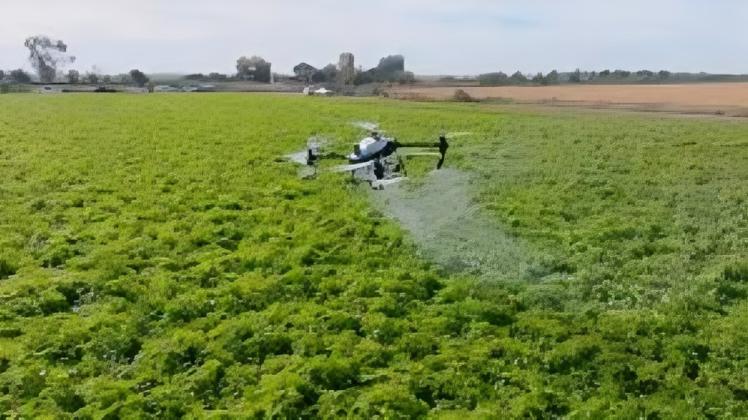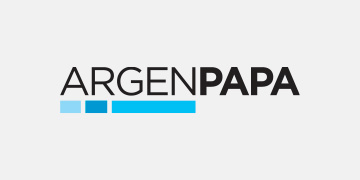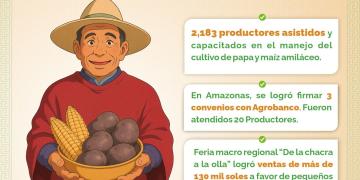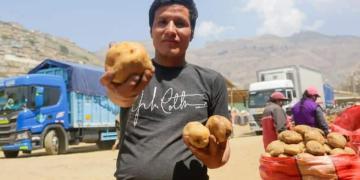Argentina: An entity warns about the regulatory framework for the use of drones in agriculture
In Argentina, nearly 90 agricultural drones were imported in 2023, and by August 2024, the total would reach 600. For 2025, projections go further, predicting operations for 2,000 units.

The use of applicator drones for weed, insect, and disease control has experienced significant growth.
Worldwide, this technology is applied to more than 500 million hectares per year, and the number of licensed pilots will exceed 300,000 by 2024. In countries like China and the United States, a third of agricultural land is sprayed with drones.
In our region, Brazil and Uruguay have made the most progress in their development. In Argentina, nearly 90 agricultural drones were imported in 2023, and by August 2024, the total would reach 600. Projections go even further by 2025, predicting operations for 2,000 units. DJI and XAG are the Chinese firms with the largest share of the local market.
In intensive agriculture, their adoption has grown, while in extensive agriculture they still face limitations for use on large areas. They are mostly useful for selective applications in patches or reinforcements in problem areas, in fallow or standing crops, according to Aapresid.
In this regard, the Pest Management Network (REM) of the producers’ organization analyzes the potential and challenges of this technology, whose operating and calibration principles are quite similar to those of ground-based equipment and aircraft.
The advantages of drones over traditional applications
Versatility: Ability to operate in areas where ground equipment cannot enter (e.g. flooded soils, tall crops, difficult topography, etc.)
Precision: allows for more localized variable treatments, sectorizing problem areas.
Potentially lower environmental impact: Working with more precise volumes would reduce overuse of products. Furthermore, they operate without the need for fuel.
Absence of land trampling: prevents losses due to excessive traffic (which can cost between 1 and 5% of yield), compaction, and soil marking.
Operator safety: thanks to remote operation.
Wide range of speed and working height.
Cost reduction: The initial investment is lower compared to aircraft and ground-based vehicles. However, it’s important to consider that the rapid evolution of this technology means more frequent replacements are required to stay up-to-date.
The disadvantages of drones compared to traditional applications
Greater risk of drift and shearing of pure mixtures: To make efficient use of the mixture during flight, droplet size must be reduced, which can increase the risk of drift. This requires special attention to environmental conditions during application. Furthermore, droplets have a higher concentration of active ingredient, increasing the risk of shearing of purer mixtures.
Difficulty in applying certain formulations: The lack of tanks with agitation systems makes it difficult to use formulations such as concentrated suspensions, wettable powders, dispersible granules, or mixtures of various active ingredients, requiring support tanks where the mixtures can be formulated and evaluated.
Reduced range: Their range depends on the battery life, which allows them to cover between 3 and 4 hectares per flight. This means additional recharging and logistics time. Furthermore, the tank’s capacity doesn’t exceed 40 to 50 liters, and they tend not to be fully filled, as the tank’s capacity limits battery life.
Only low doses are allowed: Flow rates and doses in liters/ha of active ingredient are limited by the low carrying capacity. This shouldn’t present any problems for insecticide and fungicide applications, but in the case of herbicides, effective control often depends on the application volume (L/ha) and the specific types of herbicides used.
Regulation of drone use: the major pending issue
In July 2024, the national government, through decree 663/2024, updated the regulations for the use of drones or unmanned aerial vehicles (UAVs), adapting them to the reforms of the Aeronautical Code and aligning them with international standards.
The code was also adapted to the reality of drones, national regulations were standardized with international ones (Mercosur and ICAO), and the importation of equipment was facilitated.
To provide services with UAVs, companies must be registered with the National Civil Aviation Administration (ANAC), and their pilots must be duly licensed and qualified according to the drones’ specific weight category, which, in the case of applicator drones, generally corresponds to class D.
However, drone applications of pesticides are not currently permitted in Argentina due to the lack of a specific regulatory framework by Senasa.
The agency is working with pesticide companies, to which it currently only issues permits for trials aimed at generating information for labeling, so regulations are expected to be issued soon.
Meanwhile, experts point to the need to develop a specific regulatory framework for applying pesticides with these vehicles, assessing associated risks such as drift, treatment efficacy, human exposure, and crop residues.
“This seems more than reasonable considering that drones generate finer droplets, work with lower volumes of water than airplanes, use purer mixtures, and have a less predictable application pattern than traditional application systems. Currently, most labels base their recommendations on applications of 100 liters per hectare or more,” Aapresid reports.
Drones are emerging as a technology with great potential, but their adoption and effectiveness depend on the implementation of appropriate regulations. The REM warns that everything indicates they will not replace existing technology, but rather complement it, and that, like other innovations in the sector, their implementation will depend largely on the responsibility of their users.
Fuente:




